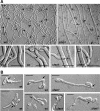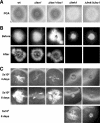Vegetative hyphal fusion is not essential for plant infection by Fusarium oxysporum
- PMID: 18039941
- PMCID: PMC2224152
- DOI: 10.1128/EC.00258-07
Vegetative hyphal fusion is not essential for plant infection by Fusarium oxysporum
Abstract
Vegetative hyphal fusion (VHF) is a ubiquitous phenomenon in filamentous fungi whose biological role is poorly understood. In Neurospora crassa, the mitogen-activated protein kinase (MAPK) Mak-2 and the WW domain protein So are required for efficient VHF. A MAPK orthologous to Mak-2, Fmk1, was previously shown to be essential for root penetration and pathogenicity of the vascular wilt fungus Fusarium oxysporum. Here we took a genetic approach to test two hypotheses, that (i) VHF and plant infection have signaling mechanisms in common and (ii) VHF is required for efficient plant infection. F. oxysporum mutants lacking either Fmk1 or Fso1, an orthologue of N. crassa So, were impaired in the fusion of vegetative hyphae and microconidial germ tubes. Deltafmk1 Deltafso1 double mutants exhibited a more severe fusion phenotype than either single mutant, indicating that the two components function in distinct pathways. Both Deltafso1 and Deltafmk1 strains were impaired in the formation of hyphal networks on the root surface, a process associated with extensive VHF. The Deltafso1 mutants exhibited slightly reduced virulence in tomato fruit infection assays but, in contrast to Deltafmk1 strains, were still able to perform functions associated with invasive growth, such as secretion of pectinolytic enzymes or penetration of cellophane sheets, and to infect tomato plants. Thus, although VHF per se is not essential for plant infection, both processes have some signaling components in common, suggesting an evolutionary relationship between the underlying cellular mechanisms.
Figures







References
-
- Altschul, S. F., W. Gish, W. Miller, C. W. Myers, and D. L. Lipman. 1990. Basic local alignment search tool. J. Mol. Biol. 215403-410. - PubMed
-
- Buller, A. 1933. Researches on fungi, vol. 5. Longman, London, United Kingdom.
-
- Chomczynski, P., and N. Sacchi. 1987. Single-step method of RNA isolation by acid guanidinium thiocyanate-phenol-chloroform extraction. Anal. Biochem. 162156-159. - PubMed
-
- Daboussi, M.-J., J.-M. Davière, S. Graziani, and T. Langin. 2002. Evolution of the Fot1 transposons in the genus Fusarium: discontinuous distribution and epigenetic inactivation. Mol. Biol. Evol. 19510-520. - PubMed
-
- Delgado-Jarana, J., A. L. Martinez-Rocha, R. Roldan-Rodriguez, M. I. Roncero, and A. Di Pietro. 2005. Fusarium oxysporum G-protein β subunit Fgb1 regulates hyphal growth, development, and virulence through multiple signalling pathways. Fungal Genet. Biol. 4261-72. - PubMed
Publication types
MeSH terms
Substances
LinkOut - more resources
Full Text Sources

